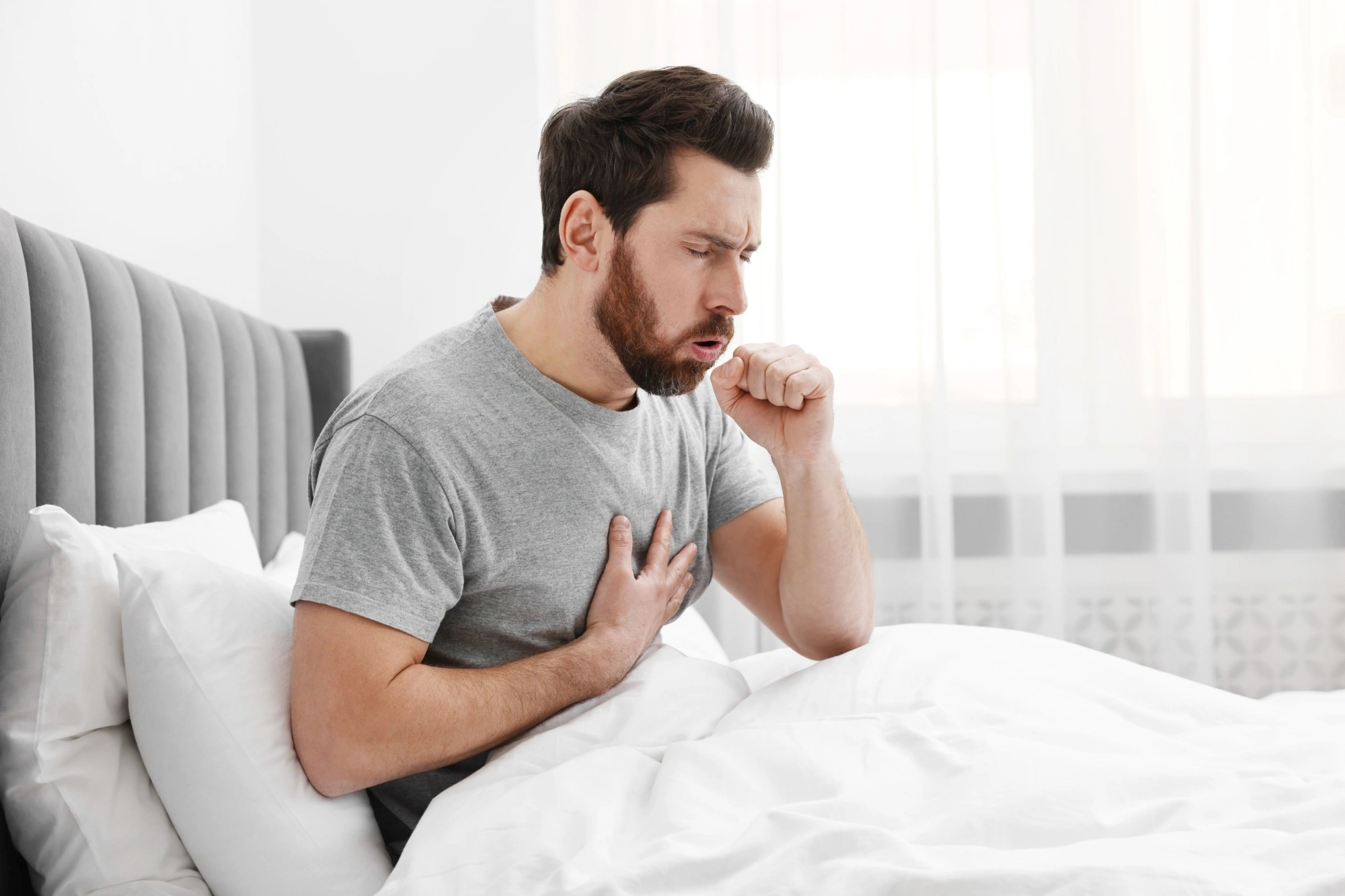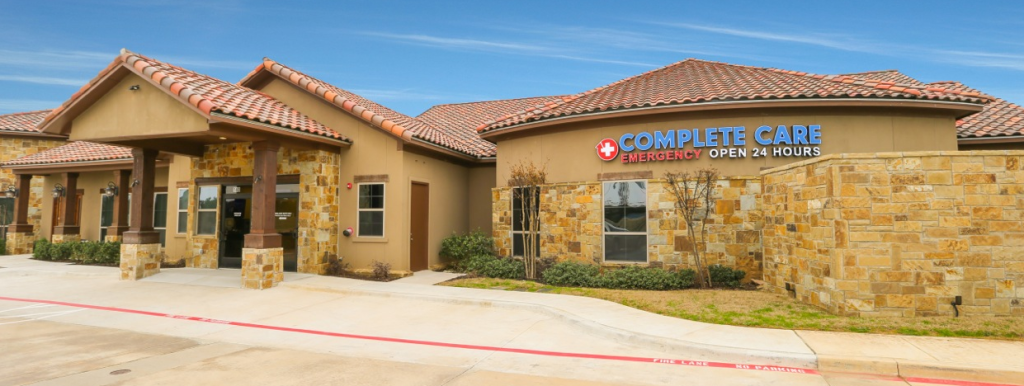
Feeling under the weather but still pushing through your daily routine? When you’re experiencing persistent respiratory symptoms that just won’t go away, you might be dealing with walking pneumonia. Also known as atypical or mycoplasma pneumonia, this milder form of pneumonia can still significantly impact your quality of life, even though you may be able to stay on your feet.
Common walking pneumonia signs and symptoms include:
- Persistent dry cough
- Fatigue and weakness
- Low-grade fever
- Chest pain
- Headaches and sore throat
- Shortness of breath
While walking pneumonia is generally milder than other forms of pneumonia, it’s important not to ignore these symptoms and prioritize your health. If you’re experiencing any of these signs, particularly if they persist for more than a few days, don’t wait to seek medical attention from a Complete Care ER location.
What are the signs of walking pneumonia?
Walking pneumonia can present with a range of symptoms that are often mild enough to be mistaken for a common cold or flu, but its persistent nature and specific characteristics set it apart. Understanding these signs can help you recognize the condition early and seek appropriate care. Here are some of the hallmark symptoms to watch for.
Persistent dry cough
While bronchitis often produces a mucus-filled cough, a persistent dry cough is one of the most common symptoms of walking pneumonia in adults. This cough occurs when bacteria irritate the airways and cause inflammation in them. Unlike other respiratory infections, this cough produces little to no mucus and can persist for weeks, even after other symptoms improve.
The cough reflex is triggered by your body’s immune response to the infection. As immune cells flood the area to fight the bacteria, they cause the airways to become more sensitive. This heightened sensitivity means even small irritants or deep breaths can trigger coughing episodes, similar to what’s seen with RSV.
Continue reading about RSV symptoms and treatments
Fatigue and weakness
Among the key symptoms of walking phenomena is profound fatigue, primarily because your body is directing energy toward fighting the infection. Your immune system requires substantial resources to produce white blood cells and antibodies, leaving you with less energy for daily activities, which is why following winter health tips like getting adequate rest is crucial.
The fatigue is often compounded by poor sleep quality due to coughing and breathing difficulties. Additionally, the infection can cause a decrease in oxygen efficiency in your lungs, meaning your body has to work harder to get the same amount of oxygen to your tissues. This creates a cycle where physical activity becomes more demanding, leading to increased tiredness.
Low-grade fever
Unlike the high fevers seen with measles, walking pneumonia typically causes a low-grade fever ranging from 99-100.9°F as your body’s natural defense mechanism against the infection. Your body raises its temperature because many harmful bacteria and viruses cannot survive well in higher temperatures. This elevated temperature also helps speed up your metabolism and immune response.
While roseola infantum virus is known for its high fever that breaks suddenly, walking pneumonia usually causes a mild temperature elevation that can fluctuate throughout the day. You might notice the fever worsening in the late afternoon or evening, a pattern known as diurnal variation. While uncomfortable, this low-grade fever is actually a sign that your immune system is actively fighting the infection.
Learn more: How long do measles last?
Chest pain
Chest pain during walking pneumonia occurs because the infection causes inflammation of the thin membranes that line the lungs and chest cavity. When these membranes become inflamed, they can rub against each other during breathing, causing sharp or stabbing pain, especially during deep breaths or coughing.
The pain may also result from strain on the chest muscles due to frequent coughing. Additionally, the inflammation can make your lung air sacs fill with fluid, causing chest pressure and discomfort. This pain might worsen with physical activity or when lying down.
Headaches and sore throat
Headaches and sore throats often appear as early symptoms of walking pneumonia due to your body’s inflammatory response to the infection. The headaches typically result from a combination of factors, including dehydration, poor sleep, and the body’s production of inflammatory chemicals called cytokines. These cytokines, while helping to fight the infection, can also cause pain and discomfort.
A sore throat occurs when the infection irritates the throat tissues and triggers inflammation. This can be exacerbated by post-nasal drip and frequent coughing. While the throat pain is usually milder than what you might experience with strep throat, it can persist for several days and may be accompanied by swollen lymph nodes in the neck.
Shortness of breath
Shortness of breath occurs because walking pneumonia affects the tiny air sacs in your lungs where oxygen exchange takes place. When these become inflamed and partially filled with fluid, they can’t function as efficiently, making it harder for your body to get the oxygen it needs. This is particularly noticeable during physical activity when your body demands more oxygen.
You may feel breathless and start breathing faster as your body struggles to get enough oxygen. While less severe than typical pneumonia, this can still be worrying, especially during activities like exercise or climbing stairs. For example, your breathing rate might increase from the normal 12-16 breaths per minute to 20 or more breaths per minute as your body works harder to maintain adequate oxygen levels.
Symptoms of walking pneumonia — FAQs
How do you tell if you have walking pneumonia?
The most telltale signs of walking pneumonia include a persistent dry cough that lasts for weeks, accompanied by fatigue and a low-grade fever that typically stays below 101°F. You might also notice mild body aches, chest pain when breathing deeply, and shortness of breath during physical activities, though these symptoms are usually less severe than regular pneumonia, allowing you to continue your daily activities.
How is walking pneumonia diagnosed?
Walking pneumonia is typically diagnosed through a combination of physical examination, in which your doctor listens to your lungs for abnormal breathing sounds and a review of your symptoms and medical history. Your healthcare provider may also order a chest X-ray to confirm the diagnosis and rule out other conditions, and in some cases, they might take a blood test or throat swab to identify the specific bacteria causing the infection.
Can walking pneumonia go away by itself?
While walking pneumonia can sometimes resolve on its own within 4-6 weeks, it’s not recommended to leave it untreated as symptoms can worsen, and recovery time may be significantly longer. Treatment with antibiotics typically speeds up recovery time to 7-10 days and helps prevent the spread of infection to others, making medical intervention the most responsible choice.
Worried about walking pneumonia symptoms? Head to a Complete Care 24/7 freestanding ER!
While walking pneumonia signs and symptoms can be mild enough to allow you to keep on your feet, they shouldn’t be ignored. Early diagnosis and treatment can help you recover faster and prevent complications. At Complete Care, we understand that respiratory symptoms can be concerning, which is why our experienced medical team is available 24/7 to provide the care you need.
With locations across Texas (Austin, Corpus Christi, Dallas/Fort Worth, East Texas, Lubbock, and San Antonio) and in Colorado Springs, you’re never far from expert medical attention. Our freestanding emergency rooms offer comprehensive diagnostic services and immediate treatment, ensuring you can get back to feeling your best as quickly as possible. Don’t let walking pneumonia symptoms linger — visit your nearest Complete Care location today.
More Helpful Articles by Complete Care:
- When to See a Doctor After a Fall
- How to Be Prepared For Medical Emergencies at Home
- What are Signs of Carbon Monoxide Poisoning?
- Winter Safety Tips for Texas
- What To Do With Upper Respiratory Infection
